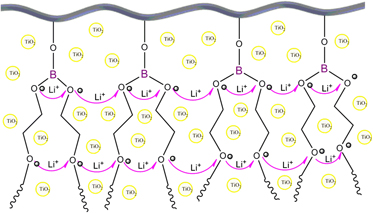Crossref Citations
This article has been cited by the following publications. This list is generated based on data provided by
Crossref.
Yan, Chunlei
Liu, Rongjun
Zhang, Changrui
Cao, Yingbin
and
Long, Xianhai
2015.
Synthesis and formation mechanism of submicrometer ZrB2 powders via the Pechini-type polymerizable complex route.
RSC Advances,
Vol. 5,
Issue. 96,
p.
78606.
Ulaganathan, Mani
Lei, Yeo Li
Flora, Xavier Helan
and
Yan, Qingyu
2016.
Charge Transport, Mechanical and Storage Performances of Sepiolite Based Composite Polymer Electrolytes.
ChemistrySelect,
Vol. 1,
Issue. 18,
p.
5821.
Vélez, J.F.
Aparicio, M.
and
Mosa, J.
2016.
Covalent silica-PEO-LiTFSI hybrid solid electrolytes via sol-gel for Li-ion battery applications.
Electrochimica Acta,
Vol. 213,
Issue. ,
p.
831.
Mohanta, Jagdeep
Singh, Udai P
Panda, Subhendu K
and
Si, Satyabrata
2016.
Enhancement of Li+ion conductivity in solid polymer electrolytes using surface tailored porous silica nanofillers.
Advances in Natural Sciences: Nanoscience and Nanotechnology,
Vol. 7,
Issue. 3,
p.
035011.
Liu, Yu
and
Yang, Yefeng
2016.
Recent Progress of TiO2-Based Anodes for Li Ion Batteries.
Journal of Nanomaterials,
Vol. 2016,
Issue. ,
p.
1.
Sadiq, M.
Arya, Anil
and
Sharma, A. L.
2017.
Recent Trends in Materials and Devices.
Vol. 178,
Issue. ,
p.
389.
Chawla, Priyanka
Trivedi, Shivangi
Pandey, Kamlesh
and
Tripathi, Mridula
2018.
Dielectric Studies of [PEO: CH3COOLi]: Graphite System Synthesized by Hot Press and Solution Cast Technique.
Proceedings of the National Academy of Sciences, India Section A: Physical Sciences,
Vol. 88,
Issue. 2,
p.
187.
Sahu, Truptimayee
and
Behera, Banarji
2019.
Dielectric, electrical and magnetic study of rare-earth-doped bismuth ferrite lead titanate.
Applied Physics A,
Vol. 125,
Issue. 6,
Arya, Anil
and
Sharma, A. L.
2019.
Electrolyte for energy storage/conversion (Li+, Na+, Mg2+) devices based on PVC and their associated polymer: a comprehensive review.
Journal of Solid State Electrochemistry,
Vol. 23,
Issue. 4,
p.
997.
Abetz, Volker
Chan, Chin Han
Luscombe, Christine K.
Matson, John B.
Merna, Jan
Nakano, Tamaki
Raos, Guido
and
Russell, Gregory T.
2020.
Quo Vadis, Macromolecular Science? Reflections by the IUPAC Polymer Division on the Occasion of the Staudinger Centenary.
Israel Journal of Chemistry,
Vol. 60,
Issue. 1-2,
p.
9.
Hoang Huy, Vo Pham
So, Seongjoon
and
Hur, Jaehyun
2021.
Inorganic Fillers in Composite Gel Polymer Electrolytes for High-Performance Lithium and Non-Lithium Polymer Batteries.
Nanomaterials,
Vol. 11,
Issue. 3,
p.
614.
Cevik, Emre
Karaman, Banu
Gunday, Seyda Tugba
and
Bozkurt, Ayhan
2021.
Graft copolymer electrolytes for electrochemical double layer electrochemical capacitor applications.
Synthetic Metals,
Vol. 278,
Issue. ,
p.
116814.
Karim, Jamilah
Aminah Mohd Noor, Siti
Zuliana Dzulkipli, Mariah
Ahmad, Azizan
Sukor Su'ait, Mohd
and
Hasyareeda Hassan, Nur
2022.
Influence of Electron beam radiation on the properties of Surface-Modified Titania-Filled gel polymer electrolytes using vinyltriethoxysilane (VTES) for lithium battery application.
Results in Chemistry,
Vol. 4,
Issue. ,
p.
100383.
Chang, Chih-Hsiang
and
Liu, Ying-Ling
2022.
Gel Polymer Electrolytes Based on an Interconnected Porous Matrix Functionalized with Poly(ethylene glycol) Brushes Showing High Lithium Transference Numbers for High Charging-Rate Lithium Ion Batteries.
ACS Sustainable Chemistry & Engineering,
Vol. 10,
Issue. 15,
p.
4904.
2023.
An Introduction to Redox Polymers for Energy‐Storage Applications.
p.
69.
Agrawal, Khusboo
Behera, Banarji
Sahoo, S.C.
Rout, S.K.
Kumar, Ashok
Pradhan, Dhiren K.
and
Das, Piyush R.
2023.
Electrical conduction mechanism in multiferroic Gd doped GaFeO3.
Chemical Physics Impact,
Vol. 7,
Issue. ,
p.
100358.
AlZaidy, Ghadah Abdulrahman
2024.
Impact of hybrid aluminum oxide/titanium dioxide nanoparticles on the structural, optical, and electrical properties of polyvinyl alcohol/ polyethylene glycol nanocomposites for flexible optoelectronic devices.
Ceramics International,
Vol. 50,
Issue. 13,
p.
23483.
Abdel-Karim, Randa Mohamed
2025.
Polymers and Two-Dimensional Nanocomposites.
p.
413.
